Influence of the Control with a Fixed and Variable Roll, Pitch, and Yaw Axis on Unmanned Aerial Vehicles Energy Consumption
Abstract
1. Introduction
1.1. Background and Motivations
1.2. Literature Review
1.3. Problem Formulation
1.4. Contribution
- i.
- Fixed yaw (condition 1B)—the UAV maintains a constant yaw angle relative to the global coordinate system and moves toward the target point by adjusting only the roll and pitch angles.
- ii.
- Continuous yaw adjustment (condition 2B)—the UAV continuously aligns its heading with the direction of travel, adjusting both the roll (for forward flight) and yaw (for course correction).
- iii.
- Continuous yaw adjustment with side tilt (condition 3B)—the UAV maintains its heading toward the target point while performing coordinated roll, pitch, and yaw changes that result in a smooth, banked turn.
- i.
- Hovering with both fixed and variable roll, pitch, and yaw angles, and
- ii.
- Circular flight at a constant speed.
2. Description of the Measuring System
2.1. Unmanned Aerial Vehicle (UAV)
2.2. Measurement System
2.3. Measurement Methodology
- i.
- Overhang (No Rotation): This maneuver served as a baseline to assess the energy consumption and stability of the UAV while maintaining a fixed position without any rotational movement. It provided crucial insights into the power requirements solely for hovering.
- ii.
- Overhang with Rotation around the Yaw Axis: Introducing rotation around the yaw axis allowed us to analyze the energy costs associated with maintaining stability while changing the UAV’s orientation. This maneuver was essential for understanding how rotational movements impact overall energy efficiency.
- iii.
- Overhang with Mixed Rotation: In this maneuver, the UAV alternated its rotation direction every 2 s, simulating dynamic flight scenarios.
- iv.
- Overhang with Height Jumps: By incorporating height variations between 1 to 2.5 m, this maneuver assessed the UAV’s ability to manage vertical movements while hovering. It offered valuable data on how changes in altitude affect energy consumption and the stability of the device.
- The roll axis (red line) makes smooth, sinusoidal movement (from 0° to 360°), which, in combination with the cosine movement (from 0° to 360°) of the pitch axis (blue line), generates a constant movement of the UAV around its axis.
- The drone holds a constant yaw axis angle (yellow line) of 0°, indicating no device rotation around its axis.
- The drone holds a constant roll axis angle (red line) of 20°, which indicates that the drone is tilted nose down, forcing it to move forward.
- The drone holds a constant pitch axis angle (blue line) of 0°, indicating no lateral tilt.
- The yaw axis (yellow line) shows a smooth, sinusoidal movement from 0° to 360°, which translates into a constant rotation of the UAV around its axis.
- The drone holds a constant roll axis angle (red line) of 20°, which indicates that the drone is tilted nose down, forcing it to move forward.
- The drone holds a constant pitch axis angle (blue line) of 20°. The device makes a lateral tilt on the inside of the arc. The maneuver throws the device into the arc.
- The yaw axis (yellow line) shows a smooth, sinusoidal movement from 0° to 360°, which translates into a constant rotation of the UAV around its axis.
3. Research Results
3.1. Overhang (No Movement in the x, y-Axis)
3.2. Circular Movement with a 2-M Diameter at a Constant Speed
4. Conclusions and Future Work
- Impact of Flight Configuration on Energy Consumption
- Energy Characteristics of Hovering
- Efficiency of Ascending and Descending
Funding
Data Availability Statement
Conflicts of Interest
References
- Lalrochunga, D.; Parida, A.; Choudhury, S. Systematic review on capacity building through renewable energy enabled IoT–Unmanned Aerial Vehicle for smart agroforestry. Clean. Circ. Bioecon. 2024, 8, 100094. [Google Scholar] [CrossRef]
- Boursianis, A.D.; Papadopoulou, M.S.; Diamantoulakis, P.; Liopa-Tsakalidi, A.; Barouchas, P.; Salahas, G.; Karagiannidis, G.; Wan, S.; Goudos, S.K. Internet of Things (IoT) and agricultural unmanned aerial vehicles (UAVs) in smart farming: A comprehensive review. Internet Things 2022, 18, 100187. [Google Scholar] [CrossRef]
- Ampatzidis, Y.; Partel, V.; Costa, L. Agroview: Cloud-based application to process, analyze and visualize UAV-collected data for precision agriculture applications utilizing artificial intelligence. Comput. Electron. Agric. 2020, 174, 105457. [Google Scholar] [CrossRef]
- Velusamy, P.; Rajendran, S.; Mahendran, R.K.; Naseer, S.; Shafiq, M.; Choi, J.-G. Unmanned aerial vehicles (UAV) in precision agriculture: Applications and challenges. Energies 2022, 15, 217. [Google Scholar] [CrossRef]
- Canicattì, M.; Vallone, M. Drones in vegetable crops: A systematic literature review. Smart Agric. Technol. 2024, 7, 100396. [Google Scholar] [CrossRef]
- Chang, C.Y.; Zhou, R.; Kira, O.; Marri, S.; Skovira, J.; Gu, L.; Sun, Y. An unmanned aerial system (UAS) for concurrent measurements of solar-induced chlorophyll fluorescence and hyperspectral reflectance toward improving crop monitoring. Agric. For. Meteorol. 2020, 294, 108145. [Google Scholar] [CrossRef]
- Kim, S.J.; Lim, G.J. Drone-aided border surveillance with an electrification line battery charging system. J. Intell. Robot. Syst. 2018, 92, 657–670. [Google Scholar] [CrossRef]
- Zhu, Y.; Yan, Y.; Dai, A.; Dai, H.; Zhang, Y.; Zhang, W.; Wang, Z.; Li, J. UAV-MSSH: A novel UAV photogrammetry-based framework for mining surface three-dimensional movement basin monitoring. Measurement 2025, 242 Pt B, 115944. [Google Scholar] [CrossRef]
- Khalil, A.; Jaradat, M.; Mukhopadhyay, S.; Abdel-Hafez, M. Autonomous control of a hybrid rolling and flying caged drone for leak detection in HVAC ducts. IEEE/ASME Trans. Mechatron. 2023, 29, 366–378. [Google Scholar] [CrossRef]
- López Peña, F.; Deibe Díaz, Á.; Orjales, F.; Losada Pita, J. A UAV system for visual inspection and wall thickness measurements in ship surveys. Measurement 2024, 238, 115262. [Google Scholar] [CrossRef]
- Li, A.; Hansen, M.; Zou, B. Traffic management and resource allocation for UAV-based parcel delivery in low-altitude urban space. Transp. Res. Part C Emerg. Technol. 2022, 143, 103808. [Google Scholar] [CrossRef]
- Kim, S.Y.; Kwon, D.Y.; Jang, A.; Ju, Y.K.; Lee, J.-S.; Hong, S. A review of UAV integration in forensic civil engineering: From sensor technologies to geotechnical, structural and water infrastructure applications. Measurement 2024, 224, 113886. [Google Scholar] [CrossRef]
- Mishra, D.; Tiwari, M.K. Integrated truck drone delivery services with optimal charging stations. Expert Syst. Appl. 2024, 254, 124254. [Google Scholar] [CrossRef]
- Szywalski, P.; Waindok, A.; Tomczuk, B. Implementation of a drones group in the area of extra high voltage grids. Przegląd Elektrotechniczny 2020, 96, 51–54. [Google Scholar] [CrossRef]
- Congress, S.S.C.; Puppala, A.J.; Escamilla, J.; Jaladurgam, R.; Kumar, P. Transportation bridge infrastructure asset condition monitoring using uncrewed aerial vehicles (UAVs). Transp. Geotech. 2024, 47, 101268. [Google Scholar] [CrossRef]
- Szywalski, P.; Waindok, A. Practical aspects of design and testing unmanned aerial vehicles. Acta Mech. Autom. 2020, 14, 50–58. [Google Scholar] [CrossRef]
- Tian, W.; Liu, L.; Zhang, X.; Shao, J. Flight trajectory and energy management coupled optimization for hybrid electric UAVs with adaptive sequential convex programming method. Appl. Energy 2024, 364, 123166. [Google Scholar] [CrossRef]
- Tang, D.Y.; Gong, M.T.; Yu, J.S.; Li, X. A power transfer model-based method for lithium-ion battery discharge time prediction of electric rotatory-wing UAV. Microelectron. Reliab. 2020, 114, 113832. [Google Scholar] [CrossRef]
- Liu, X.; Zhao, D.; Oo, N.L. Comparison studies on aerodynamic performances of a rotating propeller for small-size UAVs. Aerosp. Sci. Technol. 2023, 133, 108148. [Google Scholar] [CrossRef]
- Yıldırım, Ş.; Çabuk, N.; Bakırcıoğlu, V. Experimentally flight performances comparison of octocopter, decacopter and dodecacopter using universal UAV. Measurement 2023, 213, 112689. [Google Scholar] [CrossRef]
- De Wagter, C.; Remes, B.; Smeur, E.; van Tienen, F.; Ruijsink, R.; van Hecke, K.; van der Horst, E. The NederDrone: A hybrid lift, hybrid energy hydrogen UAV. Int. J. Hydrogen Energy 2021, 46, 16003–16018. [Google Scholar] [CrossRef]
- Hong, T.-K.; Lin, C.-Y.; Lin, H.-J.; Ruseno, N. Taiwan solar-powered UAV flight endurance record. Drone Syst. Appl. 2024, 12, 1–14. [Google Scholar] [CrossRef]
- Szywalski, P.; Waindok, A. Algorithm for planning, generating and simulating trajectories for a group of drones. In Proceedings of the 2020 International Conference on Mechatronic Systems and Materials (MSM), Bialystok, Poland, 1–3 July 2020; IEEE: Piscataway, NJ, USA, 2020. [Google Scholar] [CrossRef]
- Aslan, M.F.; Durdu, A.; Sabanci, K. Goal distance-based UAV path planning approach, path optimization and learning-based path estimation: GDRRT*, PSO-GDRRT* and BiLSTM-PSO-GDRRT*. Appl. Soft Comput. 2023, 137, 110156. [Google Scholar] [CrossRef]
- Kelner, J.M.; Burzynski, W.; Stecz, W. Modeling UAV swarm flight trajectories using rapidly-exploring random tree algorithm. J. King Saud Univ.-Comput. Inf. Sci. 2024, 36, 101909. [Google Scholar] [CrossRef]
- Chen, J.; Li, W.; Sha, Y.; Wang, Y.; Zhang, Z.; Li, S.; Wang, C.; Ma, S. Autonomous battery-changing system for UAV’s lifelong flight. Biomim. Intell. Robot. 2023, 3, 100104. [Google Scholar] [CrossRef]
- Vichitkunakorn, P.; Emde, S.; Masae, M.; Glock, C.H.; Grosse, E.H. Locating charging stations and routing drones for efficient automated stocktaking. Eur. J. Oper. Res. 2024, 316, 1129–1145. [Google Scholar] [CrossRef]
- Ahmadian, N.; Lim, G.J.; Torabbeigi, M.; Kim, S.J. Smart border patrol using drones and wireless charging system under budget limitation. Comput. Ind. Eng. 2022, 164, 107891. [Google Scholar] [CrossRef]
- Tian, W.; Liu, L.; Zhang, X.; Shao, J.; Ge, J. A coordinated optimization method of energy management and trajectory optimization for hybrid electric UAVs with PV/fuel cell/battery. Int. J. Hydrogen Energy 2024, 50 Pt B, 1110–1121. [Google Scholar] [CrossRef]
- Milutinović, D.; Casbeer, D.W.; Rasmussen, S. A switching composition of horizontal and vertical controllers for a UAV to reach a 3D waypoint. IFAC-PapersOnLine 2023, 56, 13–18. [Google Scholar] [CrossRef]


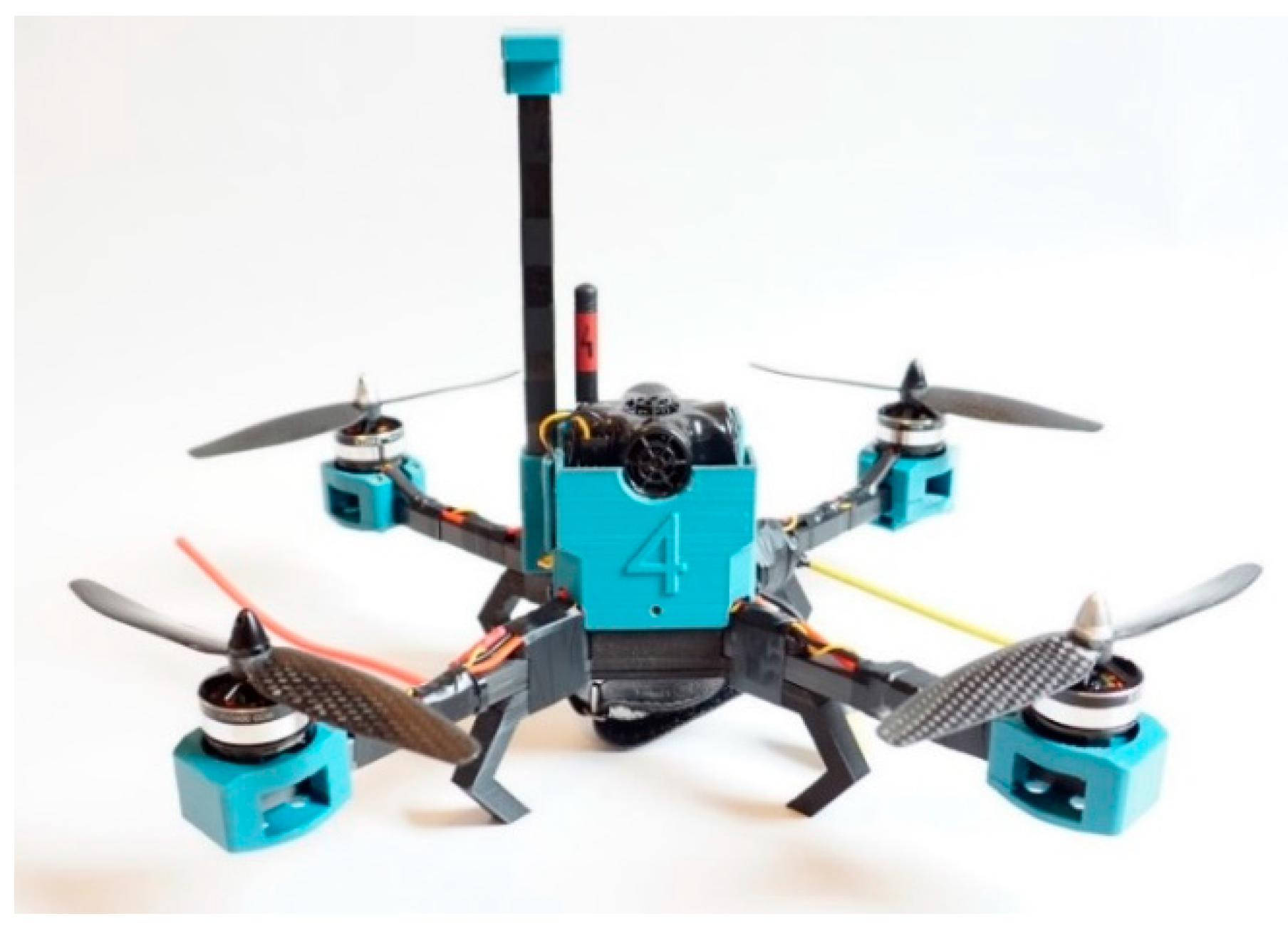
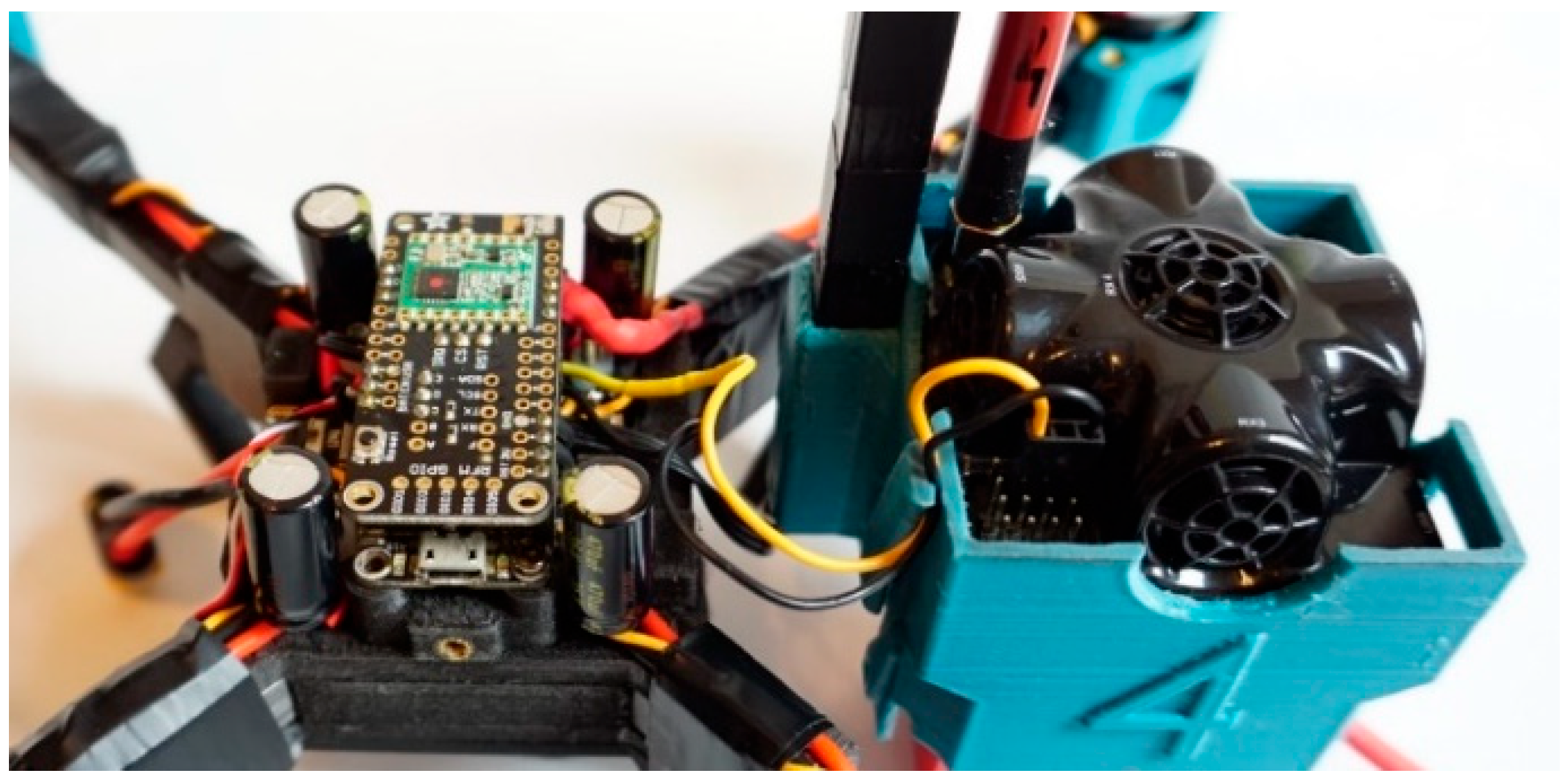


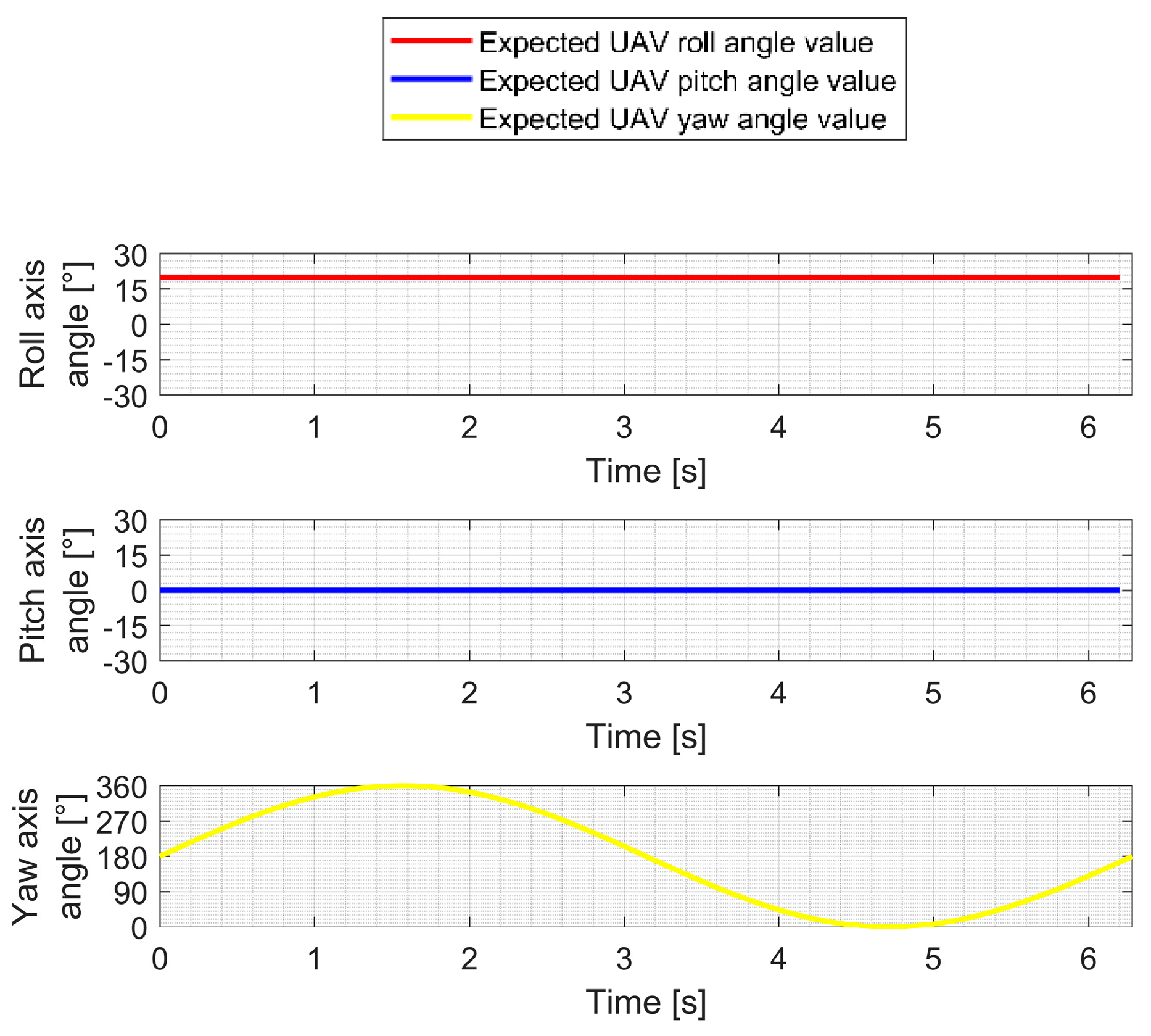
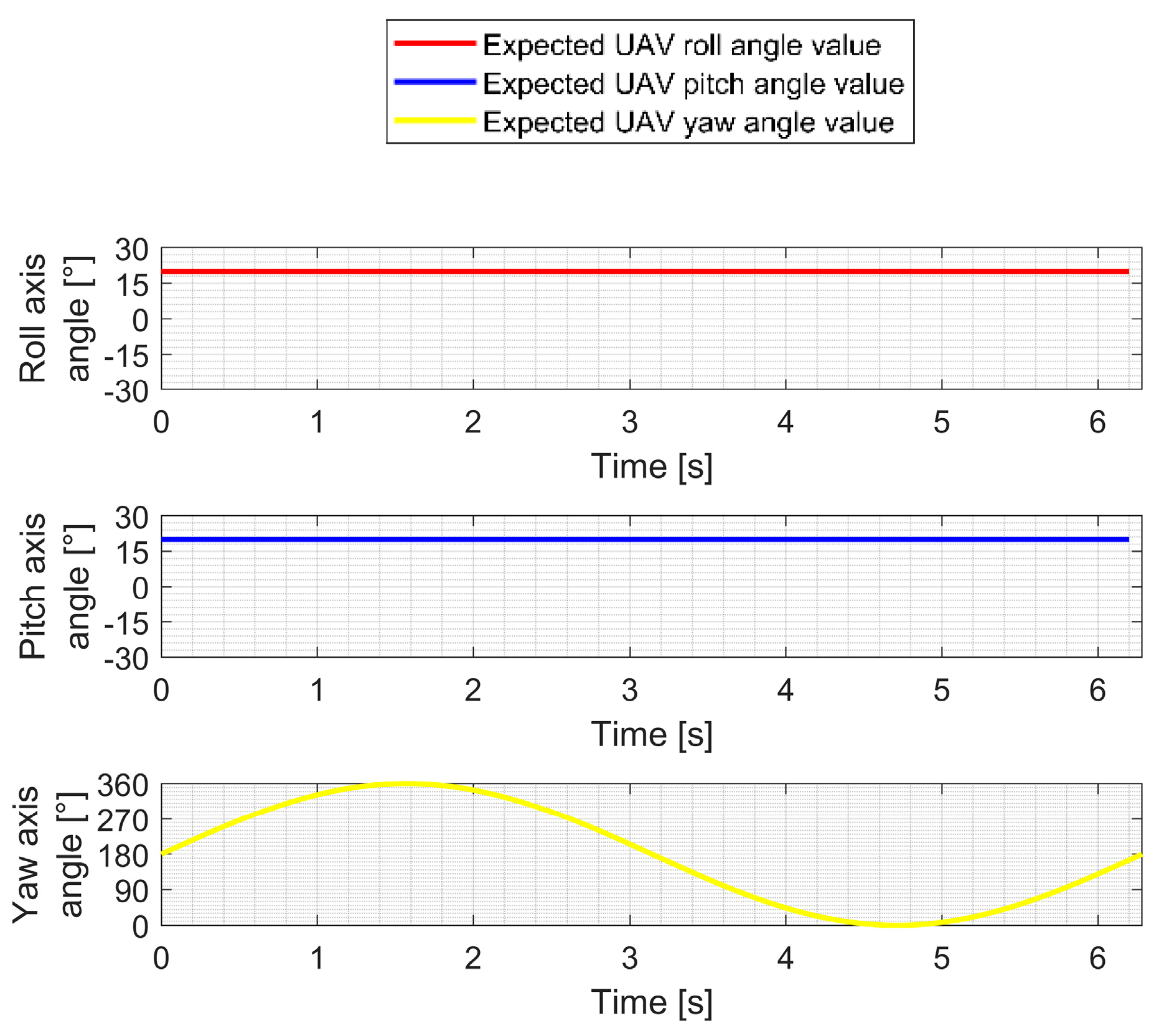
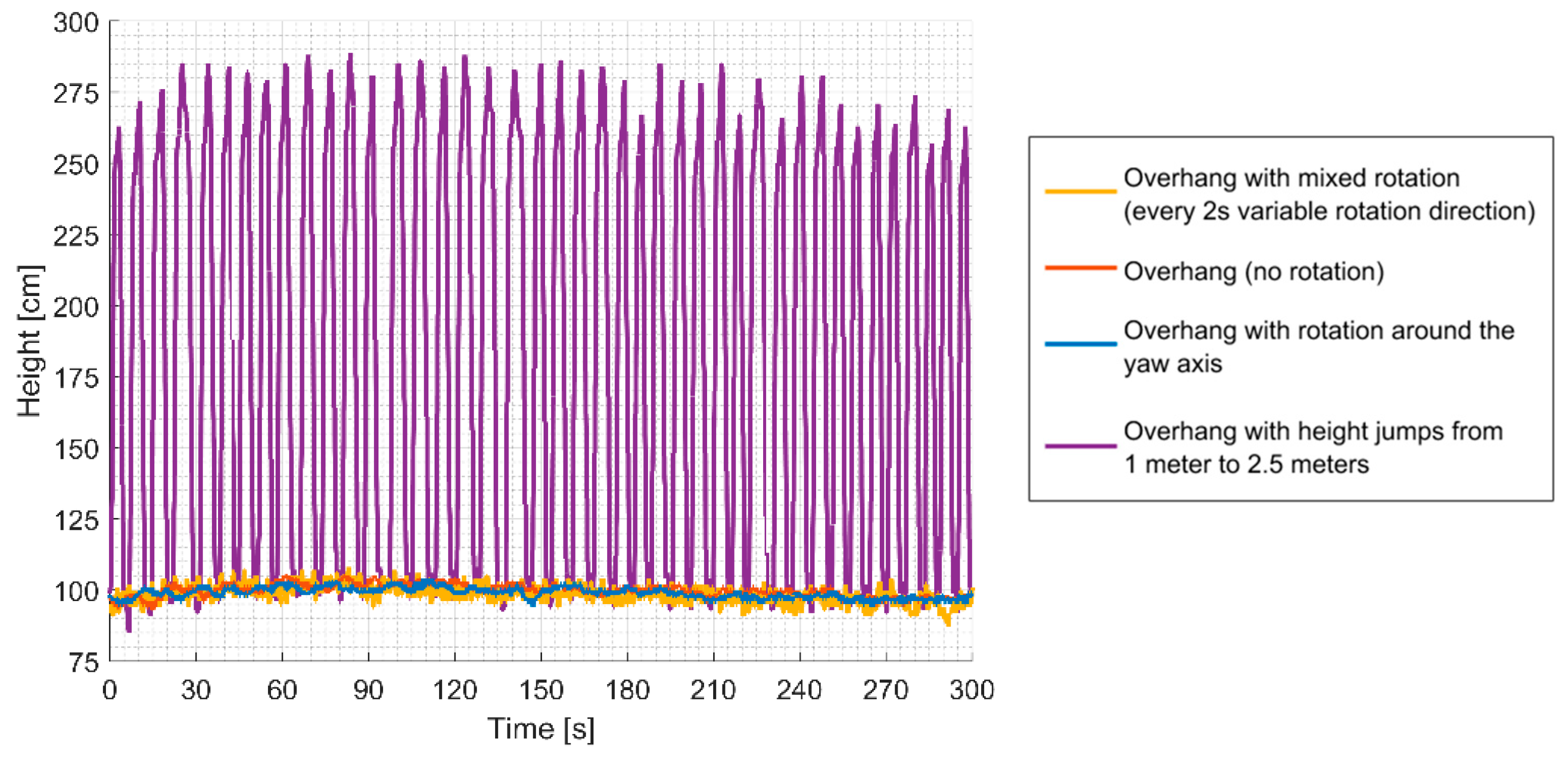


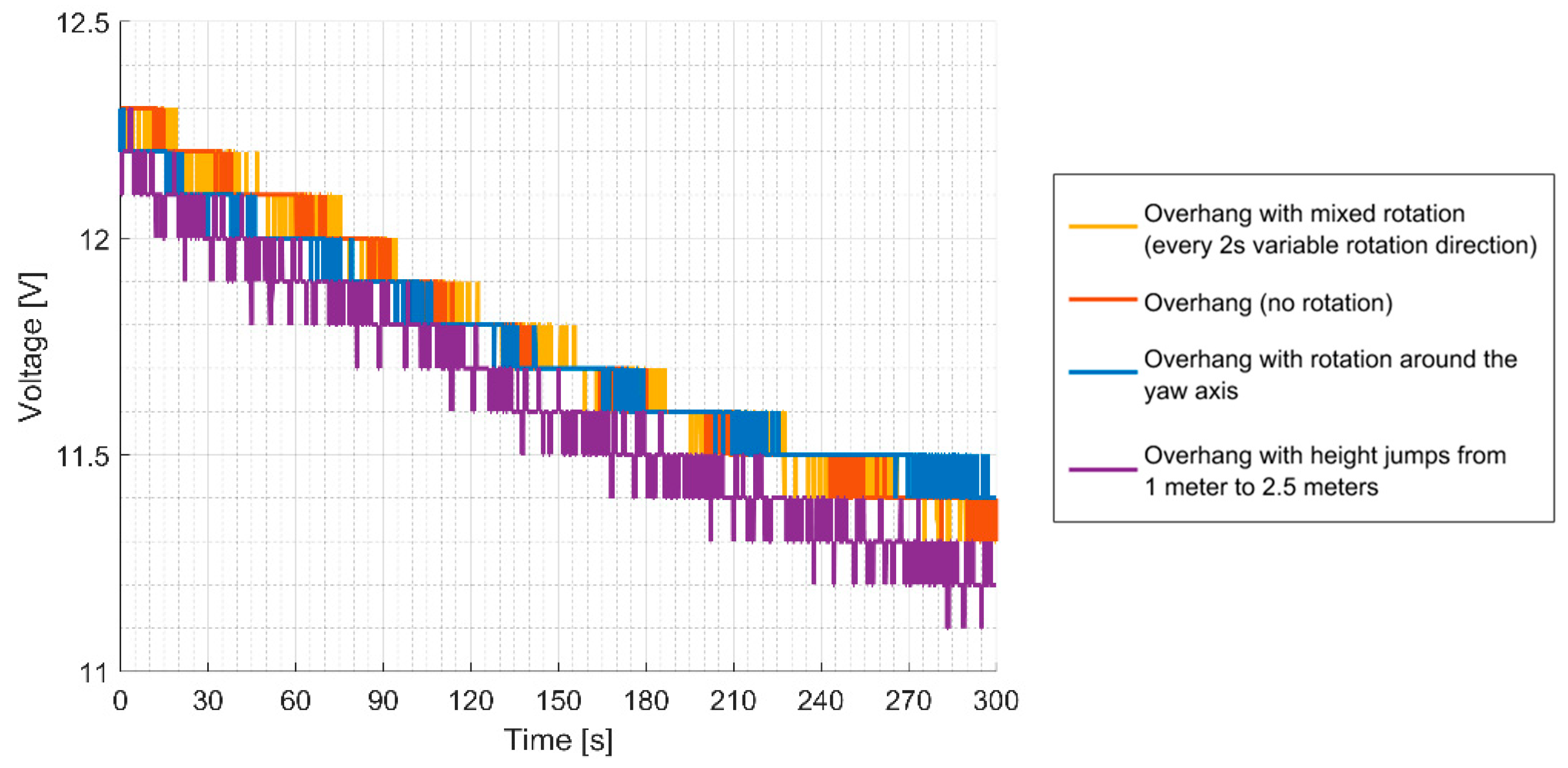
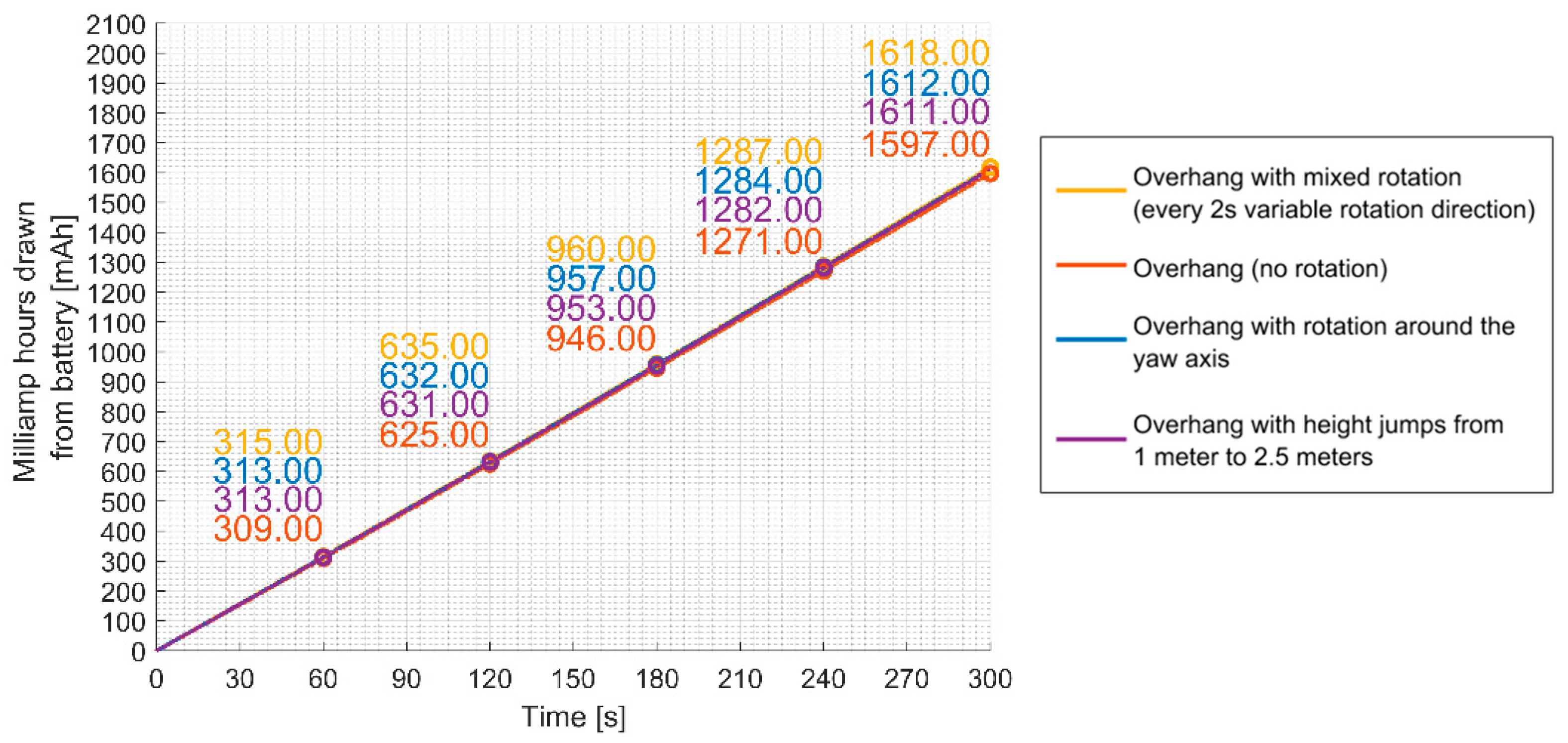


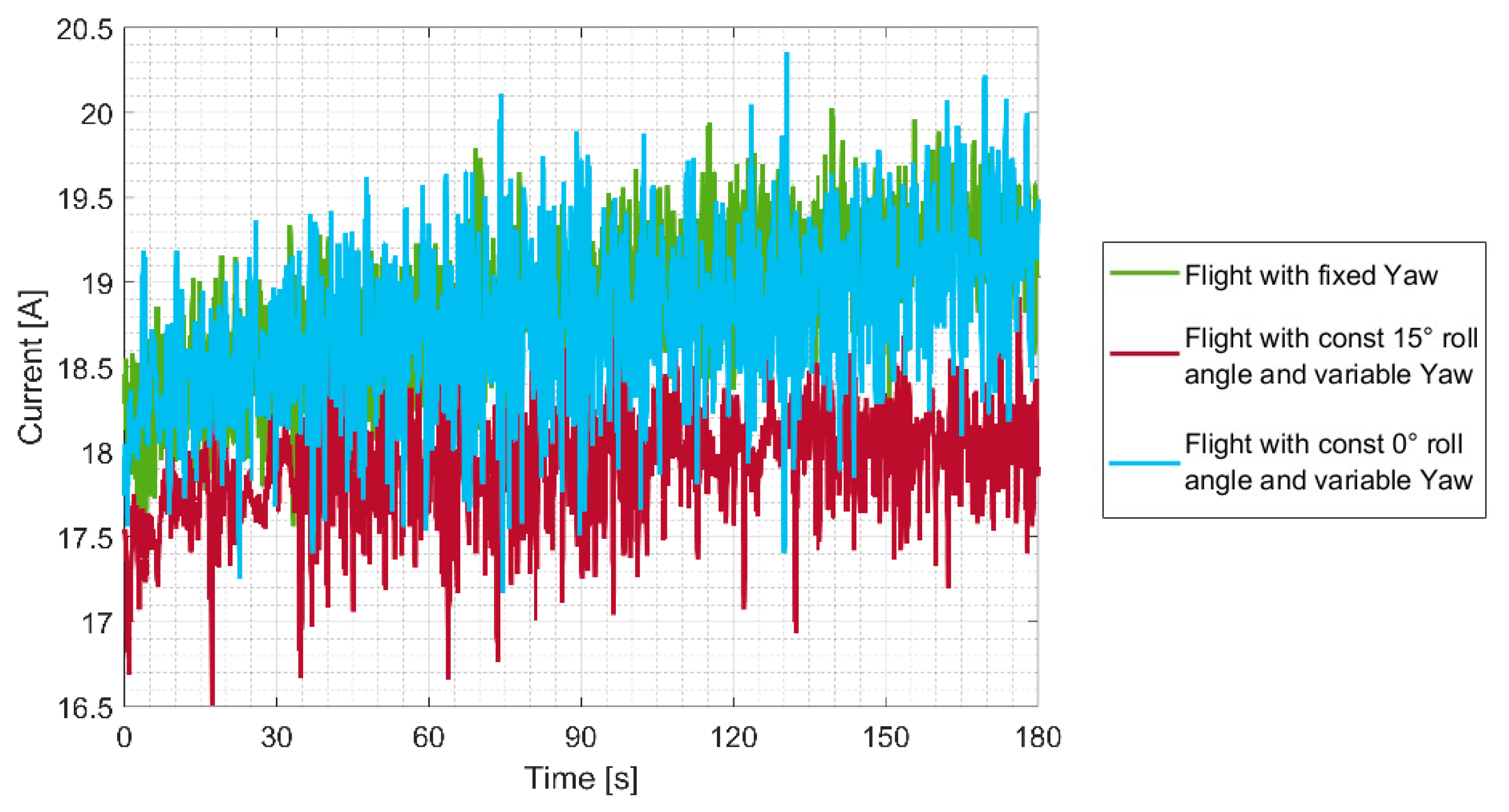

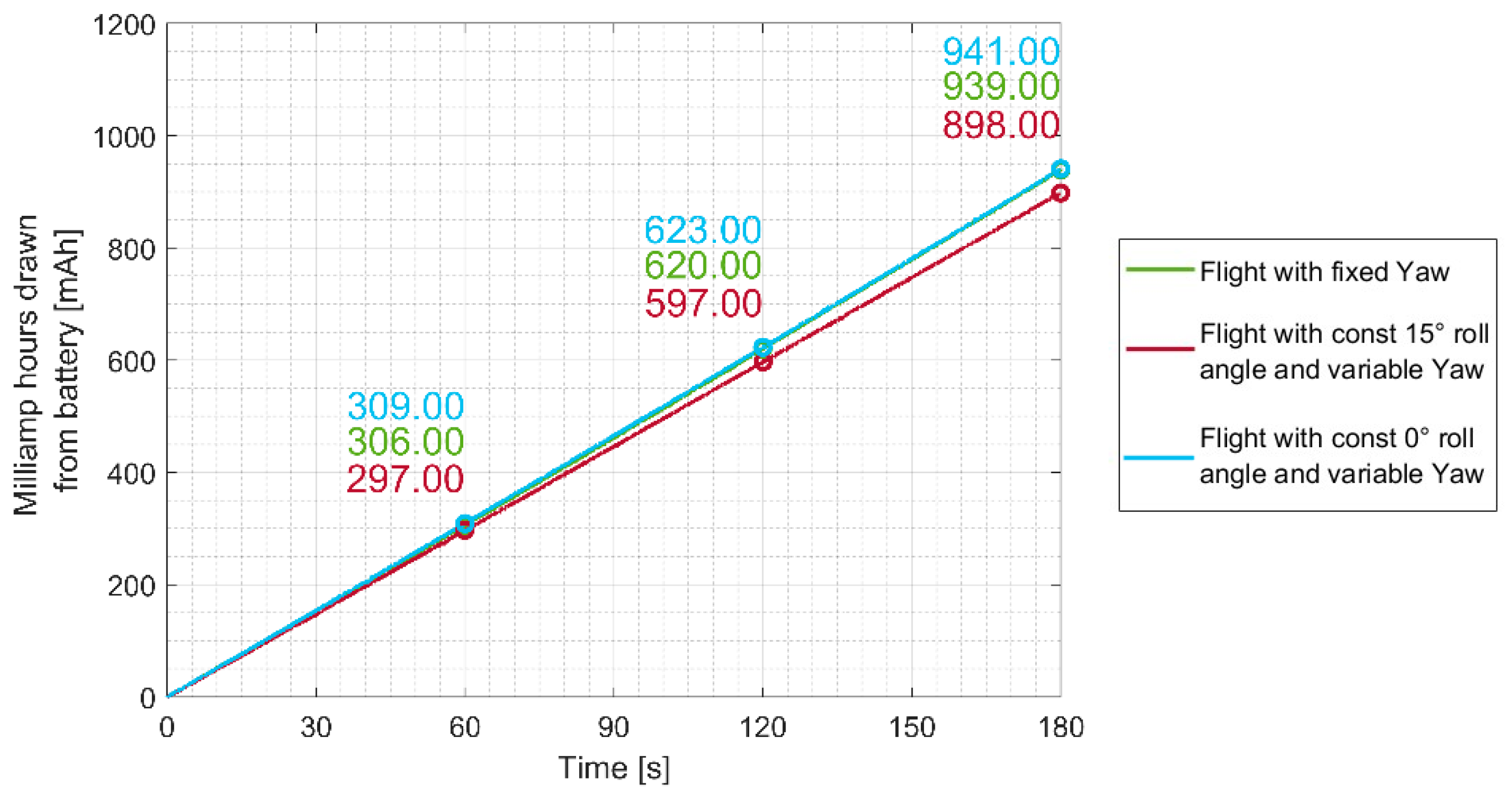
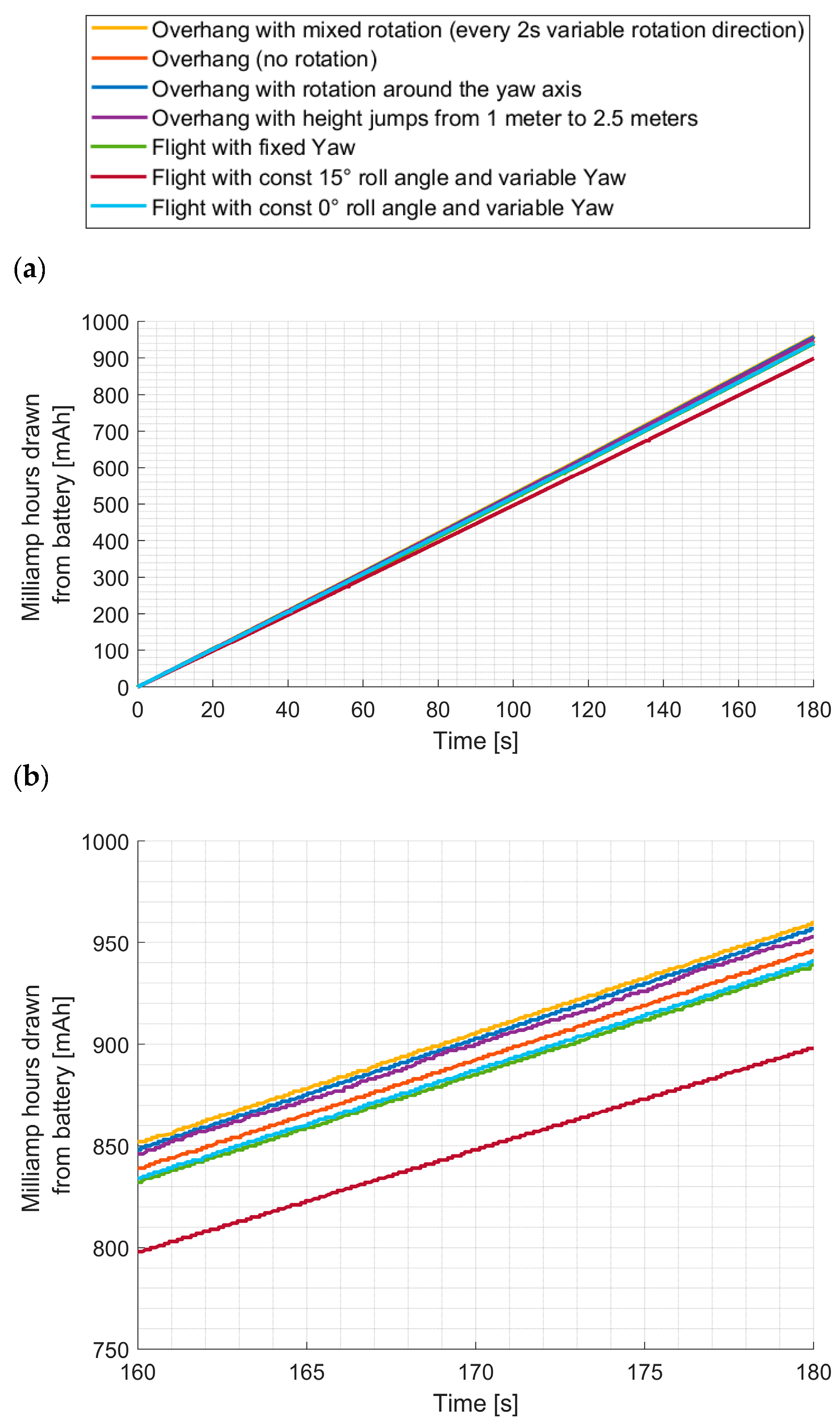
| Conditions | Action | Force Relation | |
|---|---|---|---|
| A. Basic movement | (1A) | Flight up | F1 + F2 + F3 + F4 > FG |
| (2A) | Overhang | F1 + F2 + F3 + F4 = FG | |
| (3A) | Flying down | F1 + F2 + F3 + F4 < FG | |
| (4A) | Yaw angle constant | F1 + F2 = F3 + F4 | |
| (5A) | UAV rotation Clockwise | F1 + F2 > F3 + F4 | |
| (6A) | UAV rotation Counterclockwise | F1 + F2 < F3 + F4 | |
| B. Investigated maneuvers | (1B) | Horizontal flight relative to the earth’s axis with yaw = const | F1 + F2 = F3 + F4 F1 + F4 < F3 + F2 or F1 + F4 ≥ F3 + F2 F1 + F3 < F4 + F2 or F1 + F3 ≥ F4 + F2 F1 + F2 + F3 + F4 = FG |
| (2B) | Horizontal flight relative to the earth’s axis with yaw = var and pitch = 0 | F1 + F4 < F3 + F2 or F1 + F4 ≥ F3 + F2 F1 + F3 = F4 + F2 F1 + F2 + F3 + F4 = FG | |
| (3B) | Horizontal flight relative to the earth’s axis with yaw = var and pitch = var | F1 + F4 < F3 + F2 or F1 + F4 ≥ F3 + F2 F1 + F3 < F4 + F2 or F1 + F3 ≥ F4 + F2 F1 + F2 + F3 + F4 = FG | |
| Device Parameters | |
|---|---|
| Controller |
|
| Radio module |
|
| Positioning system | Marvelmind Robotics: Indoor positioning system |
| IMU | Dual gyroscope MPU6000 and ICM20602 (SPI) |
| Magnetometer | HMC5883 |
| Optical sensor | LIDAR TFMini Plus UART/I2C—12 m |
| Barometer | BMP280 |
| Size |
|
| Battery | Lithium Polymer 11.1 V 4000 mAh |
| Propellers | Ethix K2 Bubble Gum 6 × 4 Poly Carbonate 2 × 6 × 4, 2 × CCW, 2 × CW |
| Mass | Device 610 g, Battery 290 g, Total 900 g |
| Motors | 4 × BLDC SkyRC X2205E 2400 KV, 220 W with built-in ECS regulator 20A |
| ECS | Dys SN20A BlHeli 14.6 (integrated into the engine) |
| Frame (class 300) | The frame combines a CFRP rectangular tube with 3D-printed parts made of PA12 + CF, PETG, and TPU. |
Disclaimer/Publisher’s Note: The statements, opinions and data contained in all publications are solely those of the individual author(s) and contributor(s) and not of MDPI and/or the editor(s). MDPI and/or the editor(s) disclaim responsibility for any injury to people or property resulting from any ideas, methods, instructions or products referred to in the content. |
© 2025 by the author. Licensee MDPI, Basel, Switzerland. This article is an open access article distributed under the terms and conditions of the Creative Commons Attribution (CC BY) license (https://creativecommons.org/licenses/by/4.0/).
Share and Cite
Szywalski, P. Influence of the Control with a Fixed and Variable Roll, Pitch, and Yaw Axis on Unmanned Aerial Vehicles Energy Consumption. Energies 2025, 18, 5998. https://doi.org/10.3390/en18225998
Szywalski P. Influence of the Control with a Fixed and Variable Roll, Pitch, and Yaw Axis on Unmanned Aerial Vehicles Energy Consumption. Energies. 2025; 18(22):5998. https://doi.org/10.3390/en18225998
Chicago/Turabian StyleSzywalski, Patryk. 2025. "Influence of the Control with a Fixed and Variable Roll, Pitch, and Yaw Axis on Unmanned Aerial Vehicles Energy Consumption" Energies 18, no. 22: 5998. https://doi.org/10.3390/en18225998
APA StyleSzywalski, P. (2025). Influence of the Control with a Fixed and Variable Roll, Pitch, and Yaw Axis on Unmanned Aerial Vehicles Energy Consumption. Energies, 18(22), 5998. https://doi.org/10.3390/en18225998






